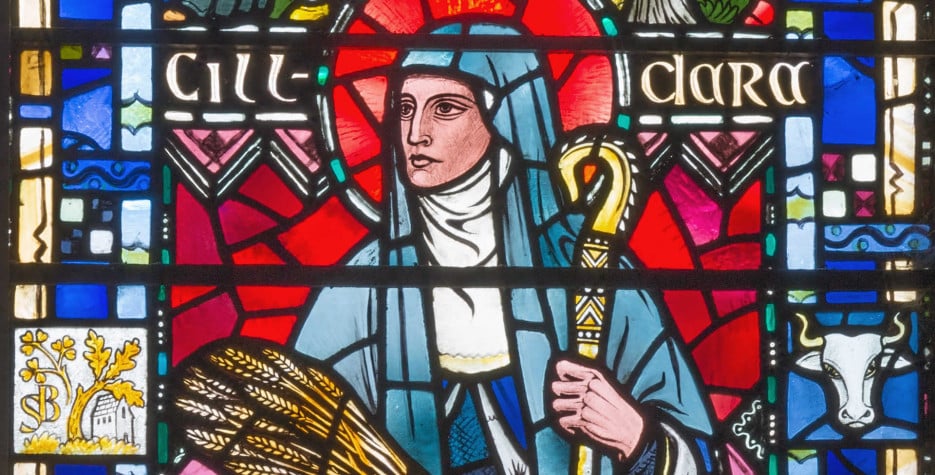When is St. Brigid's Day?
St. Brigid's Day (Gaelic: Lá Fhéile Bríde) is celebrated on February 1st. The Bank Holiday will take place on the first Monday in February each year, except where St Brigid’s day happens to fall on a Friday, in which case that Friday February 1st will be a public holiday.
A “consensus” among the government was reached, according to the Sunday Times, with employers and trade unions set to name the 10th Bank Holiday after the patron saint as part of the pandemic bonus to thank the public in general, and frontline workers in particular.
In January 2021, Minister of State Martin Heydon submitted a proposal to the Government on making St Brigid’s Day a new public holiday.
He said the holiday would help recognise the enormous sacrifices made by Irish people during the Covid pandemic and highlight better times ahead.
Mr Heydon said it would also be a welcome boost for the tourism sector during a quiet time for visitors. A bank holiday in early February “would bridge the considerable length of time between existing public holidays on January 1st and March 17th”, he said.
History of St. Brigid
St. Brigid is one of the three Patron Saints of Ireland, the other two are St. Columba and of course, St.Patrick.
Brigid is a Catholic and Orthodox saint. She was a pupil of St. Patrick and became famous for her kindness, mercy, and her miracles. In addition, Brigitte founded Ireland's most famous mixed (male and female) monastery in County Kildare.
In The Life of Brigid, her biographer, Cogitosus, recorded that Brigid formed an alliance with the hermit Conleth and, together, they created a double monastery from the Early Christian tradition. She was abbess and he was bishop. Within 100 years of her death, there was a thriving, egalitarian monastery of men and women, living and practicing their spirituality equally, side by side.
Perhaps the most famous story about St. Brigid surrounds the legend of her cloak. When Brigid was refused by the King of Leinster the land to build a convent, she asked if she could have as much land as her cloak would cover. The King allowed this, but was surprised to see Brigid's cloak grow and grow, as four of her friends took a corner each and walked pulled the cloak to cover many acres. The King then granted St. Brigid the land, and any other supplies she required, before converting to Christianity soon after.
According to another legend, Brigid gave her father’s jeweled sword to a needy man for him to barter for food.
Brigid was believed to have been buried at her monastic church in Kildare. Around the ninth century, her remains were moved to the northern town of Downpatrick in hopes of avoiding the pillages of Vikings and others. That shrine was later destroyed by English troops during the Protestant Reformation.
Various churches on the European continent claim to have relics of St. Brigid. This includes a bone fragment from Brigid’s skull, which tradition says was brought to a church in Portugal by three Irish knights. A fragment of that relic was returned in the 1930s to Brigidine Sisters elsewhere in Ireland and is stored in a small metal reliquary, shaped like an oak tree, an image associated with Brigid. That’s the relic returned to Kildare in 2024, marking the 1,500th anniversary of her death.
Brigid the Goddess
At the same time, the legends about Saint Brigid echo the myths and legends about the three-faced Celtic fertility goddess Brigid - the goddess of war, poetry, crafts, and healing. It is worth noting that before the arrival of Christianity in Ireland, the feast of the goddess Brigid was also celebrated on February 1st, the first day of Spring in the Celtic calendar.
Brigid's Cross
The Bogha Bríde or Brigid's Day Cross is the symbol of the day. Traditionally, reeds or straws are collected from the fields and crafted into a cross.
Brigid's cross is cross woven from straw or rushes. It has some variations, but the most popular designs feature a woven diamond or lozenge in the centre.
Brigid's cross is typically woven on February 1st, her feast day, as well as the festival of Imbolc in pre-Christian Ireland. Hanging Brigid's cross from the rafters of a house was believed to bring the blessing and protection of the saint for the remainder of the year. The practice of crafting Brigid's crosses declined in the 20th century.
Despite this, Brigid's cross remains a national symbol of Ireland, along with the shamrock and Celtic harp. From 1962 to 1995, it was incorporated into the logo of the national broadcaster, Raidió Teilifís Éireann(RTÉ).
Imbolc
Imbolc is a Celtic pagan religious holiday celebrated from February 1–2 each year. Imbolc originated as a festival in honour of the pagan goddess Brigid, which marked the halfway point between the winter solstice and the spring equinox.
Imbolc was one of four Gaelic seasonal festivals, some of which still have echoes in the festivals of today. Along with Imbolc Beltane (May 1st), Lammas (August 1st) and Samhain (November 1st - All Saints' Day).


